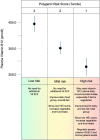Contribution of genetic ancestry and polygenic risk score in meeting vitamin B12 needs in healthy Brazilian children and adolescents
- PMID: 34099811
- PMCID: PMC8184816
- DOI: 10.1038/s41598-021-91530-7
Contribution of genetic ancestry and polygenic risk score in meeting vitamin B12 needs in healthy Brazilian children and adolescents
Abstract
Polymorphisms in genes related to the metabolism of vitamin B12 haven't been examined in a Brazilian population. To (a) determine the correlation between the local genetic ancestry components and vitamin B12 levels using ninety B12-related genes; (b) determine associations between these genes and their SNPs with vitamin B12 levels; (c) determine a polygenic risk score (PRS) using significant variants. This cross-sectional study included 168 children and adolescents, aged 9-13 years old. Total cobalamin was measured in plasma. Genotyping arrays and whole exome data were combined to yield ~ 7000 SNPs in 90 genes related to vitamin B12. The Efficient Local Ancestry Inference was used to estimate local ancestry for African (AFR), Native American, and European (EUR). The association between the genotypes and vitamin B12 levels were determined with generalized estimating equation. Vitamin B12 levels were driven by positive (EUR) and negative (AFR, AMR) correlations with genetic ancestry. A set of 36 variants were used to create a PRS that explained 42% of vitamin level variation. Vitamin B12 levels are influenced by genetic ancestry and a PRS explained almost 50% of the variation in plasma cobalamin in Brazilian children and adolescents.
Conflict of interest statement
J.K. was employee at Nestlé Research and participated in the experimental design of the study and in writing the final manuscript. He is currently employed by Vydiant, Folson, CA, USA. S.M., J.C., O.C., S.M., S.P., A.C. and P.D. are employees of Nestlé Research and did not participate in the experimental design. All the others authors declare no conflict of interest.
Figures




Similar articles
-
Dietary intake of folate, vitamin B6, and vitamin B12, genetic polymorphism of related enzymes, and risk of breast cancer: a case-control study in Brazilian women.BMC Cancer. 2009 Apr 24;9:122. doi: 10.1186/1471-2407-9-122. BMC Cancer. 2009. PMID: 19389261 Free PMC article.
-
Folate, vitamin B12 and Homocysteine status in the post-folic acid fortification era in different subgroups of the Brazilian population attended to at a public health care center.Nutr J. 2015 Feb 19;14:19. doi: 10.1186/s12937-015-0006-3. Nutr J. 2015. PMID: 25886278 Free PMC article.
-
Methylenetetrahydrofolate reductase genotype, vitamin B12, and folate influence plasma homocysteine in hemodialysis patients.Am J Kidney Dis. 2002 May;39(5):1032-9. doi: 10.1053/ajkd.2002.32779. Am J Kidney Dis. 2002. PMID: 11979347
-
An update on vitamin B12-related gene polymorphisms and B12 status.Genes Nutr. 2018 Feb 6;13:2. doi: 10.1186/s12263-018-0591-9. eCollection 2018. Genes Nutr. 2018. PMID: 29445423 Free PMC article. Review.
-
The prevalence of cobalamin deficiency among vegetarians assessed by serum vitamin B12: a review of literature.Eur J Clin Nutr. 2014 May;68(5):541-8. doi: 10.1038/ejcn.2014.46. Epub 2014 Mar 26. Eur J Clin Nutr. 2014. PMID: 24667752 Review.
Cited by
-
Human Nutrition Research in the Data Era: Results of 11 Reports on the Effects of a Multiple-Micronutrient-Intervention Study.Nutrients. 2024 Jan 5;16(2):188. doi: 10.3390/nu16020188. Nutrients. 2024. PMID: 38257081 Free PMC article. Review.
-
Maternal Vitamin B12 Status during Pregnancy and Early Infant Neurodevelopment: The ECLIPSES Study.Nutrients. 2023 Mar 22;15(6):1529. doi: 10.3390/nu15061529. Nutrients. 2023. PMID: 36986259 Free PMC article.
-
Bioactive compounds for human and planetary health.Front Nutr. 2023 Jul 17;10:1193848. doi: 10.3389/fnut.2023.1193848. eCollection 2023. Front Nutr. 2023. PMID: 37545571 Free PMC article. Review.
References
-
- Institute of Medicine. The Development of DRIs 1994–2004: Lessons Learned and New Challenges: Workshop Summary (National Academies Press, 2008).
-
- Committee DGA. Scientific Report of the 2020 Dietary Guidelines Advisory Committee Advisory Report to the Secretary of Agriculture and Secretary of Health and Human Services. U.S. Department of Agriculture; 2020.
Publication types
MeSH terms
Substances
LinkOut - more resources
Full Text Sources

